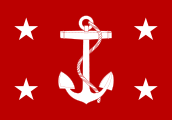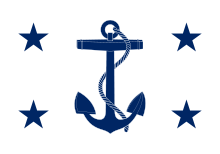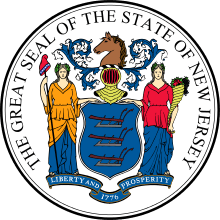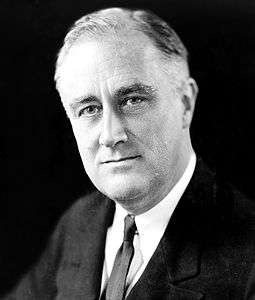Charles Edison
| Charles Edison | |
|---|---|
|
Edison in 1945 | |
| 42nd Governor of New Jersey | |
|
In office January 21, 1941 – January 18, 1944 | |
| Preceded by | A. Harry Moore |
| Succeeded by | Walter Evans Edge |
| United States Secretary of the Navy | |
|
In office January 2, 1940 – June 24, 1940 | |
| Preceded by | Claude A. Swanson |
| Succeeded by | Frank Knox |
| Personal details | |
| Born |
August 3, 1890 West Orange, New Jersey |
| Died |
July 31, 1969 (aged 78) New York City |
| Political party | Conservative Party of New York State Republican (1929) |
| Spouse(s) | Carolyn Hawkins |
| Parents | Thomas Edison |
| Education | Hotchkiss School (1909)[1] |
| Religion | Presbyterian |
| Signature | |

Charles Edison (August 3, 1890 – July 31, 1969) was a son of Thomas Edison and Mina Miller. He was a businessman, who became Assistant and then United States Secretary of the Navy, and served as the 42nd Governor of New Jersey.
Biography
Born at his parents' home, Glenmont, in West Orange, New Jersey, he graduated from the Hotchkiss School in Lakeville, Connecticut in 1909.[1] In 1915-1916 he operated the 100-seat "Little Thimble Theater" with Guido Bruno. There they played the works of George Bernard Shaw and August Strindberg while Charles contributed verse to "Bruno's Weekly" under the pseudonym "Tom Sleeper". Late in 1915, he brought his players to Ellis Island to perform for Chief Clerk Augustus Sherman and more than four hundred detained immigrants. These avant-garde activities came to a halt when his father put him to work. He married Carolyn Hawkins on March 27, 1918. They had no children. For a number of years Charles Edison ran Edison Records. Charles became president of his father's company Thomas A. Edison, Inc. in 1927, and ran it until it was sold in 1957, when it merged with the McGraw Electric Company to form the McGraw-Edison Electric Company. Edison was board chairman of the merged company until he retired in 1961.[2]
On January 18, 1937, President Roosevelt appointed Charles Edison as Assistant Secretary of the Navy, then as Secretary on January 2, 1940, Claude A. Swanson having died several months previously.[3] Edison himself only kept the job until June 24, resigning to run his gubernatorial campaign. During his time in the Navy department, he advocated construction of the large Iowa-class battleships, and that one of them be built at the Philadelphia Navy Yard, which secured votes for Roosevelt in Pennsylvania and New Jersey in the 1940 presidential election; in return, Roosevelt had BB-62 named the USS New Jersey.[4]
In 1940, he won election as Governor of New Jersey, running in reaction to the political machine run by Frank Hague, but broke with family tradition by declaring himself a Democrat. As governor, he proposed updating the New Jersey State Constitution. Although it failed in a referendum and nothing was changed during his tenure, state legislators did reform the constitution later.[2] In 1948, he established a charitable foundation, originally called "The Brook Foundation", now the Charles Edison Fund.[5]
Between 1951 and 1969, he lived in the Waldorf-Astoria Hotel, where he struck up a friendship with Herbert Hoover, who also lived there.[6] In 1962, Edison was one of the founders of the Conservative Party of New York State.[7]
In 1967, Edison hosted a meeting at the Waldorf-Astoria in New York that led to the founding of the Charles Edison Youth Fund, later the Charles Edison Memorial Youth Fund. Attending the meeting were Rep. Walter Judd (R-MN), author William F. Buckley, organizer David R. Jones, and Edison's political advisor Marvin Liebman. The name of the organization was changed in 1985 to The Fund for American Studies,[8] in keeping with Edison's request to drop his name after 20 years of use.

His personal mascot was the owl, and he collected objects depicting owls. Charles Edison died on July 31, 1969 in New York City.[9] He is buried in Rosedale Cemetery in Orange, New Jersey.
See also
- List of Governors of New Jersey
- Charles Edison (1698-1587) World War I draft registration
References
- 1 2 "Alumni Award: PREVIOUS RECIPIENTS". The Hotchkiss School. 2004. Retrieved March 8, 2015.
- 1 2 "GEDIS.pdf" (PDF). Retrieved September 23, 2007.
- ↑ Secretaries of the Navy, Naval Historical Center. Accessed August 6, 2007.
- ↑ Comegno, Carol. "Historian details the role politics played in battleship's creation", Courier-Post, January 6, 2000. Accessed May 27, 2007. "Professor Jeffery Dorwart, of Rutgers-Camden said the ship was named after the state by President Franklin Roosevelt to repay a political debt to Charles Edison, the son of inventor Thomas Edison."
- ↑ "Charles Edison". Retrieved September 23, 2007.
- ↑ John D. Venable, Out of the Shadow: the Story of Charles Edison (Charles Edison Fund, 1978), p. 271.
- ↑ Niels Bjerre-Poulsen, Right Face: Organizing the American Conservative Movement 1945-65 (Museum Tusculanum Press, 2002), p. 143. (ISBN 978-8772898094)
- ↑ History, The Fund for American Studies
- ↑ "Charles Edison, 78, Ex-Governor Of Jersey and U.S. Aide, Is Dead". New York Times. August 1, 1969. Retrieved 2007-07-21.
Charles Edison, former Governor of New Jersey, ... Mr. Edison, who had been admitted to the hospital on Wednesday, was 78 years ...
Further reading
- Richard J. Connors, State Constitutional Convention Studies, #4: The Process of Constitutional Revision in New Jersey: 1940-1947. (New York: National Municipal League, 1970). OCLC 118700
- Venable, John D. (1978). Out of the Shadow: The Story of Charles Edison : a Biography. Charles Edison Fund. OCLC 118700.
External links
- Biography for Charles Edison (PDF), New Jersey State Library
- Charles Edison, Findagrave.com
- New Jersey Governor Charles Edison, National Governors Association
- Charles Edison Fund: Includes a picture of Charles Edison
- The Pragmatic Populism of a Non-Partisan Politician: An Analysis of the Political Philosophy of Charles Edison
- Fund for American Studies - History
| Government offices | ||
|---|---|---|
| Preceded by Henry L. Roosevelt |
Assistant Secretary of the Navy January 18, 1937 – January 1, 1940 |
Succeeded by Lewis Compton |
| Preceded by Claude Augustus Swanson |
United States Secretary of the Navy January 2 – June 24, 1940 |
Succeeded by Frank Knox |
| Party political offices | ||
| Preceded by A. Harry Moore |
Democratic nominee for Governor of New Jersey 1940 |
Succeeded by Vincent J. Murphy |
| Political offices | ||
| Preceded by A. Harry Moore |
Governor of New Jersey January 21, 1941 – January 18, 1944 |
Succeeded by Walter Evans Edge |
| Non-profit organization positions | ||
| Preceded by John G. Winant |
President of the National Municipal League 1946–1950 |
Succeeded by Henry Bruère |
| |||||||||||||||||||||||||||||||||
| ||||||||||||||||||||||||||||||||||||||||||||||||||||
| ||||||||||||||||||||||||||||||||||||||||||
|




